An Approach Based on Landsat Images for Shoreline Monitoring to Support Integrated Coastal Management—A Case Study, Ezbet Elborg, Nile Delta, Egypt
Abstract
:1. Introduction
2. Study Area
3. Materials and Methods
3.1. Satellite Images and Pre-Processing
3.2. Images Classification
3.3. Accuracy Assessment of Classified Images
3.4. Comparative Study
3.5. Shoreline Indicators
3.6. Proposed Method for the Shoreline Changes Detection
- Image to Image registration process is implemented for all satellite images. The Satellite map from Google earth software was used as a base map to georeferenced the Landsat image acquired in 1985 through image to map referencing. Then, the Landsat image was considered as the master image that was utilized to register other images through image-to-image registration. To accurately register each image, a total of at least 35 ground control points (GCP) was examined and matched with all images. These points include: road intersections, prominent geomorphologic features and river channels as shown in Figure 1. After rectification, the root mean square error (RMSE) for the deviations between the GCP and GP location is determined and kept smaller than 0.45 pixels to ensure a good geo-referencing of the images. The images of the study area are extracted by clipping it from the registered satellite images based on GIS solution.
- Image classification is done using SVMs. The SVM algorithm is designed using MATLAB software. By this classification, two classes are created and called “Water” and “Other-Fields.”
- Image classification accuracy is determined as presented before in the “image classification” section. KAPPA coefficients are then calculated and evaluated.
- The classified image is converted to vector layers using ArcGIS to extract shorelines.
- Additional verification is done by comparing the extracted shorelines using the proposed approach with the GPS land survey to evaluate its applicability to monitor shoreline changes.
- Finally, change detection of coastal areas is studied using the generated vector maps by the ArcGIS.
4. Results and Discussion
5. Conclusions
Author Contributions
Funding
Acknowledgments
Conflicts of Interest
References
- Goncalves, R.M.; Awange, J.L. Three Most Widely Used GNSS-Based Shoreline Monitoring Methods to Support Integrated Coastal Zone Management Policies. Surv. Eng. ASCE 2017, 143, 1–11. [Google Scholar] [CrossRef]
- Nagy, G.J.; Gomez, E.M.; Kay, R.; Glavovic, B.; Kelly, M.; Kay, R.; Travers, A. A risk-based and participatory approach to assessing climate vulnerability and improving governance in coastal Uruguay. Climate Change and the Coast; Taylor & Francis Group CRC Press: London, UK, 2015; pp. 357–378. [Google Scholar]
- Valentini, N.; Spongier, A.; Damiani, L. A new video monitoring system in support of Coastal Zone Management at Apulia Region, Italy. Ocean Coast. Manag. 2017, 142, 122–135. [Google Scholar] [CrossRef]
- Sharaan, M.A. Study for Improving Efficiency of Egyptian Fishing Ports. Ph.D. Thesis, School of Energy Resources, Environment, Chemical and Petrochemical Engineering, E–JUST, Alexandria, Egypt, 2018. [Google Scholar]
- Stanley, D.; Warne, A. Nile Delta: Recent Geological Evolution and Human Impact. Science 1993, 260, 628–634. [Google Scholar] [CrossRef] [PubMed]
- Sestini, G. Nile Delta: A review of depositional environments and geological history. Geol. Soc. Lond. Spec. Publ. 1989, 41, 99–127. [Google Scholar] [CrossRef]
- Dibajnia, M.; Soltanpour, M.; Vafai, F.; Shoushtari, S.M.H.J.; Kebriaee, A. A shoreline management plan for Iranian coastlines. Ocean Coast. Manag. 2012, 63, 1–15. [Google Scholar] [CrossRef]
- Samaras, A.G.; Koutitas, C.G. An integrated approach to quantify the impact of watershed management on coastal morphology. Ocean Coast. Manag. 2012, 69, 68–77. [Google Scholar] [CrossRef]
- Ismail, N.; El-Sayed, W. Seawall-Waves Interaction and Impact on Sediment Morphology. In Proceedings of the Conference on Coastal Engineering Practice 2011, San Diego, CA, USA, 21–24 August 2011. [Google Scholar] [CrossRef]
- Balaji, R.; Kumar, S.S.; Misra, A. Understanding the effects of seawall construction using a combination of analytical modelling and remote sensing techniques: Case study of Fansa, Gujarat, India. Int. J. Ocean Clim. Syst. 2017, 8, 153–160. [Google Scholar] [CrossRef] [Green Version]
- Anand, R.; Chandrasekhar, B.N.; Magesh, S. Shoreline change rate and erosion risk assessment along the Trou Aux Biches—Mont Choisy beach on the northwest coast of Mauritius using GIS-DSAS technique. Environ. Earth 2016, 75, 1–12. [Google Scholar] [CrossRef]
- Kabuth, A.K.; Kroon, A.; Pedersen, J.B.T. Multidecadal shoreline changes in Denmark Multidecadal shoreline changes in Denmark. Coast. Res. 2014, 30, 714–728. [Google Scholar] [CrossRef]
- Masria, A.; Nadaoka, K.; Negm, A.M.; Iskander, M.M. Detection of shoreline and land cover changes around Rosetta Promontory, Egypt, based on remote sensing analysis. Land 2015, 4, 216–230. [Google Scholar] [CrossRef] [Green Version]
- Warnasuriya, T.W.S. Mapping land-use pattern using image processing techniques for medium resolution satellite data: A Case study in Matara District, Sri Lanka. In Proceedings of the International conference on advances in ICT for emerging regions (ICTer), Colombo, Sri Lanka, 24–26 August 2015; pp. 106–111. [Google Scholar] [CrossRef]
- Bouchahma, M.; Yan, W. Automatic measurement of shoreline change on Djerba island of Tunisia. J. Comput. Inf. Sci. 2012, 5, 17–24. [Google Scholar] [CrossRef] [Green Version]
- Di, K.; Wang, J.; Ma, R.; LI, R. Automated shoreline extraction from high-resolution IKONOS satellite images. In Proceedings of the (ASPRS) Annual Conference Proceedings, Anchorage, AK, USA, 5–9 May 2003; Available online: https://www.researchgate.net/publication/241058589_Automatic_shoreline_extraction_from_high_resolution_IKONOS_satellite_imagery (accessed on 1 May 2019).
- Dewidar, K.M.; Frihy, O.E. Pre and post-beach response to engineering hard structures using Landsat time-series at the northwestern part of the Nile delta, Egypt. J. Coast. Conser. 2008, 11, 33–142. [Google Scholar] [CrossRef]
- El Banna, M.M.; Herher, M. Detecting temporal shoreline changes and erosion/accretion rates, using remote sensing, and their associated sediment characteristics along the coast of North Sinai, Egypt. J. Environ. Geol. 2009, 8, 1419–1427. [Google Scholar] [CrossRef]
- Giannini, M.B.; Parente, C. An Object Based Approach for Coastline Extraction from Quickbird Multispectral Images. Int. J. Eng. Tech (IJET) 2014, 6, 2698–2704. Available online: https://www.researchgate.net/publication/270280894_An_object_based_approach_for_coastline_extraction_from_Quickbird_multispectral_images (accessed on 1 May 2019).
- Chen, W.W.; Chang, H.K. Estimation of shoreline position and change from satellite images considering tidal variation. J. Estuar. Coast. Shelf Sci. 2009, 84, 54–60. [Google Scholar] [CrossRef]
- Plant, N.G.; Aarninkhof, S.G.J.; Turner, I.L.; Turner, K.S. The performance of shoreline detection models applied to video images. J. Coast. Res. 2007, 23, 658–670. [Google Scholar] [CrossRef]
- Dinesh, P.K.; Gopinath, G.; Laluraj, C.M.; Seralathan, P.; Mitra, D. Change detection studies of Sagar Island, India, using Indian remote sensing satellite 1c linear imaging self-scan sensor III data. J. Coast. Res. 2007, 23, 1498–1502. [Google Scholar] [CrossRef]
- Kuleli, T.; Guneroglu, A.; Karsli, F.; Dihkan, M. Automatic detection of shoreline change on coastal Ramsar wetlands of Turkey. J. Ocean. Eng. 2011, 38, 1141–1149. [Google Scholar] [CrossRef]
- Wang, C.; Zhang, J.; Ma, Y. Coastline interpretation from multispectral remote sensing images using an association rule algorithm. Int. J. Remote Sens. 2010, 31, 6409–6423. [Google Scholar] [CrossRef]
- Teodoro, A.C. Optical satellite remote sensing of the coastal zone environment—An overview. In Environment Applications of Remote Sensing; In Tech Open: London, UK, 2016; pp. 165–196. [Google Scholar] [CrossRef] [Green Version]
- Zhang, H.; Jiang, Q.; Xu, J. Coastline extraction using Support Vector Machine from Remote Sensing Image. J. Multimedia 2013, 8, 175–182. Available online: https://www.researchgate.net/publication/269808229_Coastline_Extraction_Using_Support_Vector_Machine_from_Remote_Sensing_Image (accessed on 15 May 2019).
- Yun, J.C.; Myung, H.J. Comparison between a machine-learning-based method and a water-index-based method for shoreline mapping using a high-resolution satellite image acquired in Hwado Island, South Korea. J. Sens. 2017, 13, 8245204. [Google Scholar] [CrossRef] [Green Version]
- Choung, Y.J. Mapping 3D shorelines using KOMPSAT-2 images and airborne LiDAR data. J. Korean Soc. Surv. Geod. Photogramm. Cartogr. 2015, 33, 23–30. [Google Scholar] [CrossRef] [Green Version]
- Davis, C.O.; Kavanaugh, M.; Letelier, R.; Bissett, W.P.; Kohler, D. Spatial and spectral resolution considerations for imaging coastal waters. In Proceedings of the International Society for Optical Engineering (SPIE), San Diego, CA, USA, 26–30 August 2007. [Google Scholar] [CrossRef] [Green Version]
- Dewidar, K.M.; Frihy, O.E. Automated techniques for quantification of beach change rates using Landsat series along the North-eastern Nile Delta, Egypt. Oceangr. Mar. Sci. 2010, 1, 28–39. Available online: https://www.researchgate.net/publication/228989842_Automated_techniques_for_quantification_of_beach_change_rates_using_Landsat_series_along_the_Northeastern_Nile_Delta_Egypt (accessed on 1 November 2019).
- Philip, N.Q.; Kwasi, A.A.; Kufogbe, S.K. Medium resolution satellite images as a tool for monitoring shoreline change: A case study of the Eastern coast of Ghana. J. Coast. Res. 2013, 65, 511–520. [Google Scholar] [CrossRef]
- Maglione, P.; Parente, C.; Vallario, A. coastline extraction using high resolutionWorldView-2 satellite images. Euro. J. Remote Sens. 2014, 47, 685–699. [Google Scholar] [CrossRef]
- Sekovski, I.; Stecchi, F.; Mancini, F.; Del Rio, N.L. Image classification methods applied to shoreline extraction on very high-resolution multispectral images. Int. J. Remote Sens. 2014, 35, 3556–3578. [Google Scholar] [CrossRef]
- El Banna, M.M. Damietta sand spit, Nile Delta, Egypt. Egypt Sedimentol. 2004, 12, 269–282. [Google Scholar]
- Khalifa, A.M.; Soliman, M.R.; Yassin, A.A. Assessment of a combination between hard structures and sand nourishment eastern of Damietta harbor using numerical modeling. Alex. Eng. J. 2017, 56, 545–555. [Google Scholar] [CrossRef]
- Wang, X.; Liu, Y.; Ling, F.; Liu, Y.; Fang, F. Spatio-temporal change detection of Ningbo coastline using Landsat time-series images during 1976–2015. ISPRS Int. J. Geo-Inf. 2017, 6, 68. [Google Scholar] [CrossRef] [Green Version]
- United States Geological Survey (USGS). Available online: https://earthexplorer.usgs.gov/ (accessed on 10 October 2018).
- Olmanson, L.G.; Kloiber, S.M.; Bauer, M.E.; Brezonik, P.L. Image Processing Protocol for Regional Assessment of Lake Water Quality; Water Resources Center Technical Report 14; University of Minnesota: St. Paul, MN, USA, 2001. [Google Scholar]
- Lu, D.; Weng, Q. A survey of image classification methods and techniques for improving classification performance. Int. J. Remote Sens. 2007, 28, 823–870. [Google Scholar] [CrossRef]
- Elgohary, T.; Mubasher, A.; Salah, H. Significant deep wave height prediction by using support vector machine approach (Alexandria as case of study). Int. J. Curr. Eng. Tech. 2017, 7, 135–143. Available online: https://inpressco.com/significant-deep-wave-height-prediction-by-using-support-vector-machine-approach-alexandria-as-case-of-study/ (accessed on 25 December 2018).
- Kavzoglu, T.; Colkesen, I. A kernel functions analysis for support vector machines for land cover classification. Int. J. Appl. Earth Obs. Geoinf. 2009, 11, 352–359. [Google Scholar] [CrossRef]
- Rwanga, S.S.; Ndambuki, J.M. Accuracy assessment of land use/land cover classification using remote sensing and GIS. Int. J. Geosci. 2017, 8, 611–622. [Google Scholar] [CrossRef] [Green Version]
- Jenness, J.; Wynne, J.J. 2007 Kappa Analysis (kappa_stats.avx) Extension for ArcView3.x.JennessEnterprises. Available online: http://www.jennessent.com/arcview/kappa_stats.htm (accessed on 20 November 2018).
- Lipakis, M.; Chrysoulakis, N.; Kamarianakis, Y. Shoreline Extraction using Satellite Imagery. In Beach Erosion Monitoring. Results from BEACHMED/e-OpTIMAL Project (Optimization des Techniques Integrées de Monitorage Appliquées aux Lottoraux) INTERREG IIIC South; Pranzini, E., Wetzel, E., Eds.; Nuova Grafica Fiorentina: Florence, Italy, 2008; pp. 81–95. [Google Scholar]
- Boak, E.H.; Turner, I.L. Shoreline definition and detection: A review. J. Coast. Res. 2005, 214, 688–703. [Google Scholar] [CrossRef] [Green Version]
- Enríquez, A.R.; Marcos, M.; Álvarez-Ellalcuría, A.; Orfila, A.; Gomis, D. Changes in beach shoreline due to sea level rise and waves under climate change scenarios: Application to the Balearic Islands (western Mediterranean). J. Nat. Hazards Earth Syst. Sci. 2017, 17, 1075–1089. [Google Scholar] [CrossRef] [Green Version]
- Foody, G.M.; Muslim, A.M.; Atkinson, P.M. Super-resolution mapping of the waterline from remotely sensed data. Int. J. Remote Sens. 2005, 26, 5381–5392. [Google Scholar] [CrossRef]
- Esmail, M.; Mahmod, W.E.; Fath, H. Assessment and prediction of shoreline change using multi-temporal satellite images and statistics: Case study of Damietta coast. Egypt Appl. Ocean Res. 2019, 82, 274–282. [Google Scholar] [CrossRef]
- El-Banna, M.M.; Frihy, O.E. Human-induced changes in the geomorphology of the northeastern coast of the Nile Delta. Egypt Geomorphol. 2009, 107, 72–78. [Google Scholar] [CrossRef]
- El-Asmar, H.; El-Kafrawy, S.; Taha, M. Monitoring Coastal Changes along Damietta Promontory and the Barrier Beach toward Port Said East of the Nile Delta. Egypt J. Coast. Res. 2014, 30, 993–1005. [Google Scholar] [CrossRef]

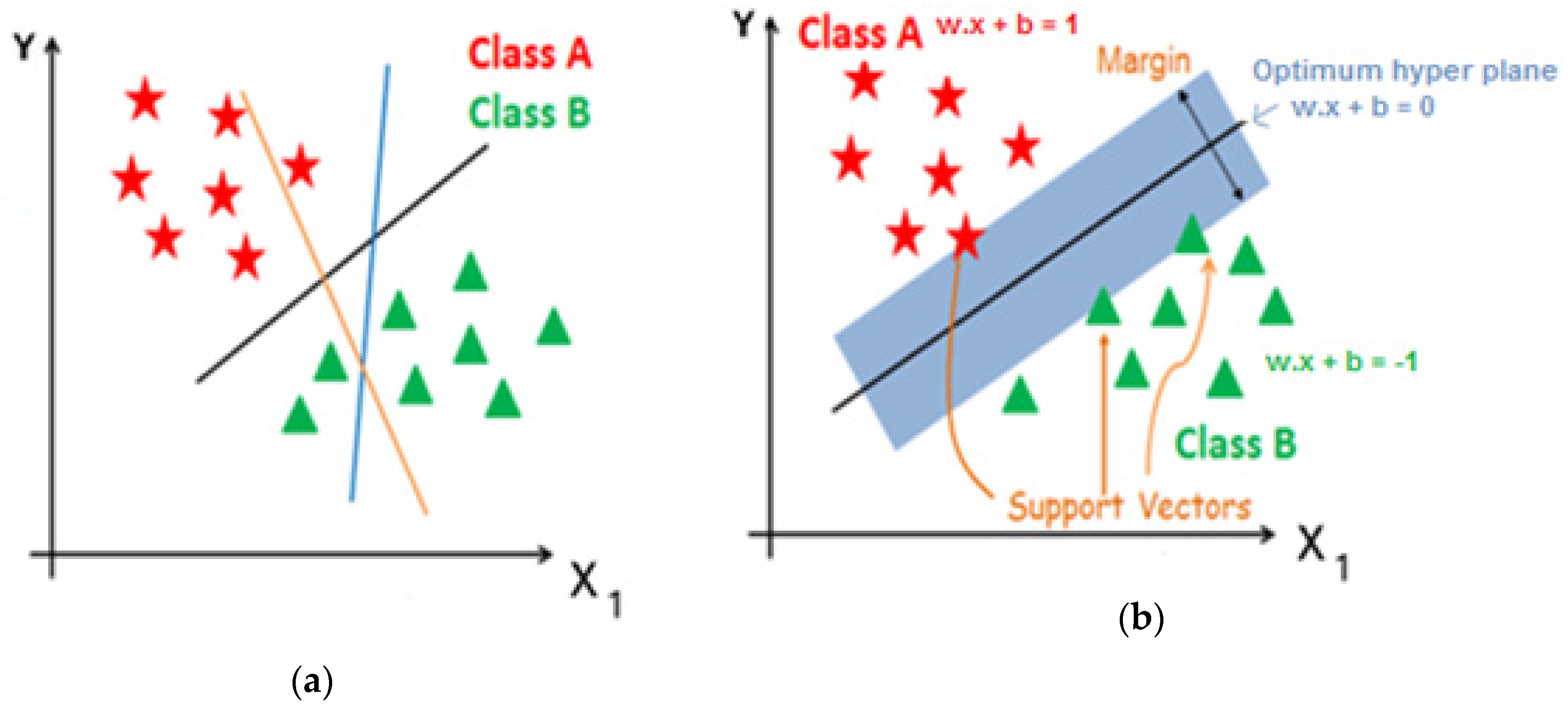
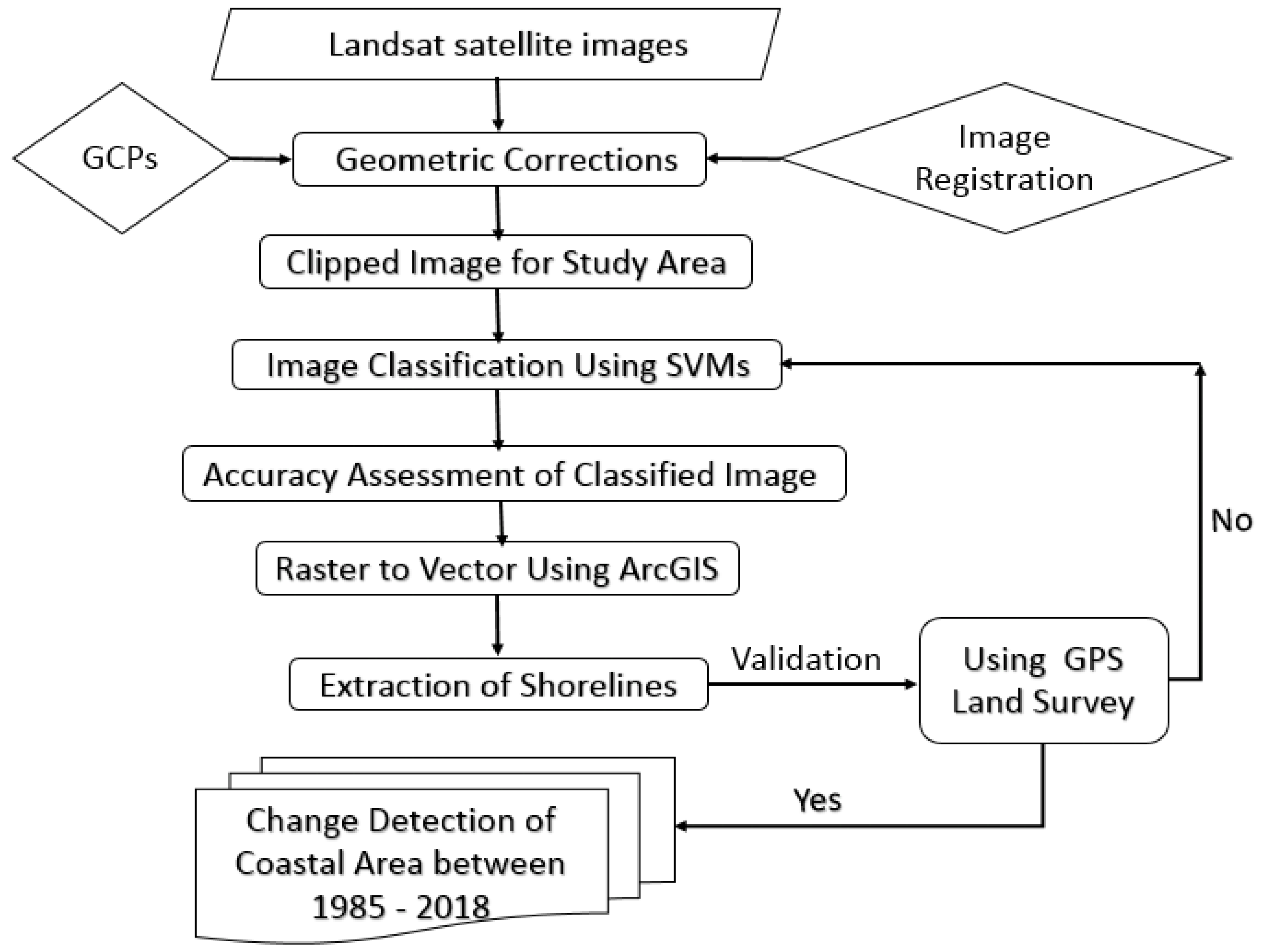
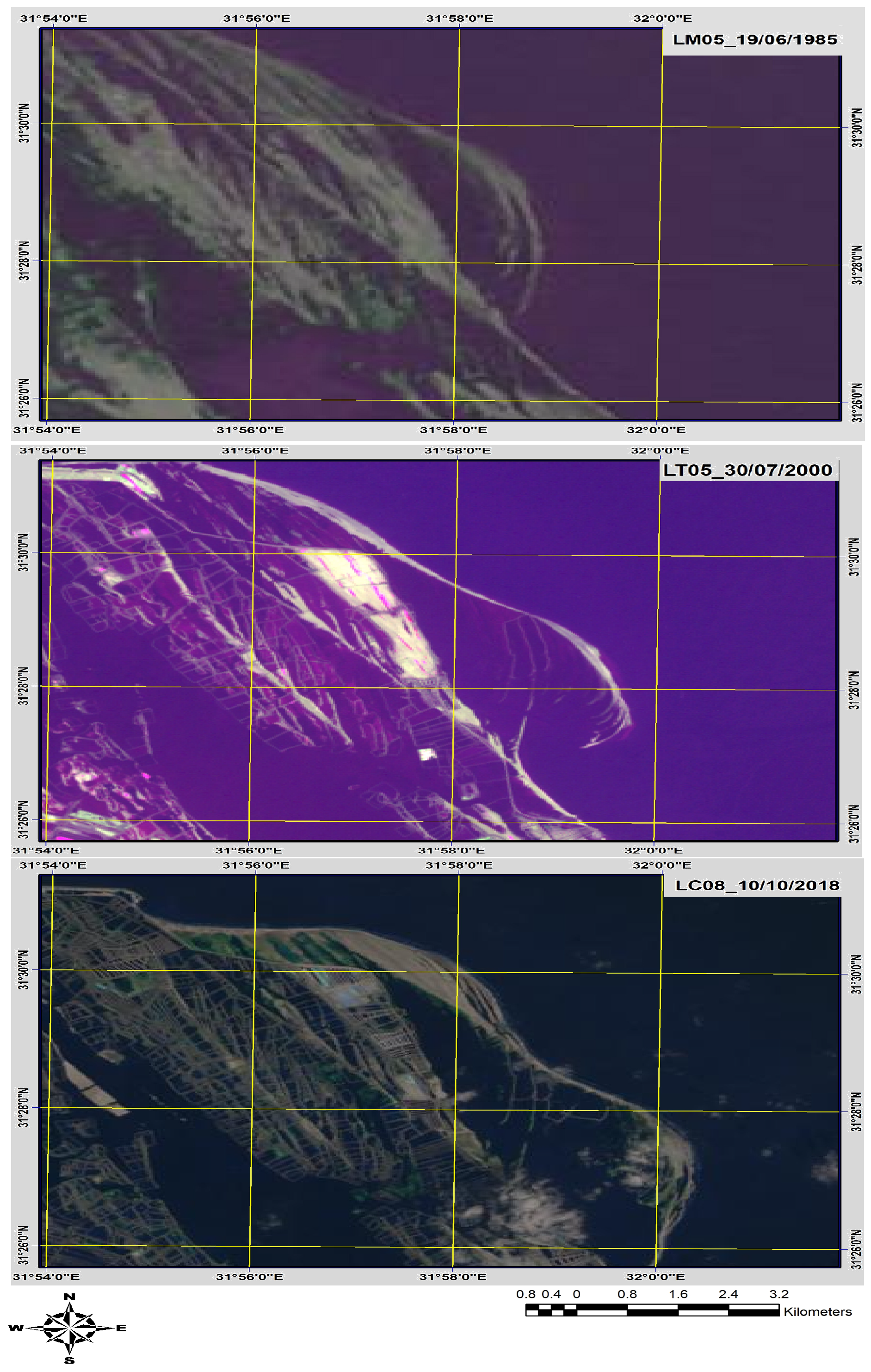
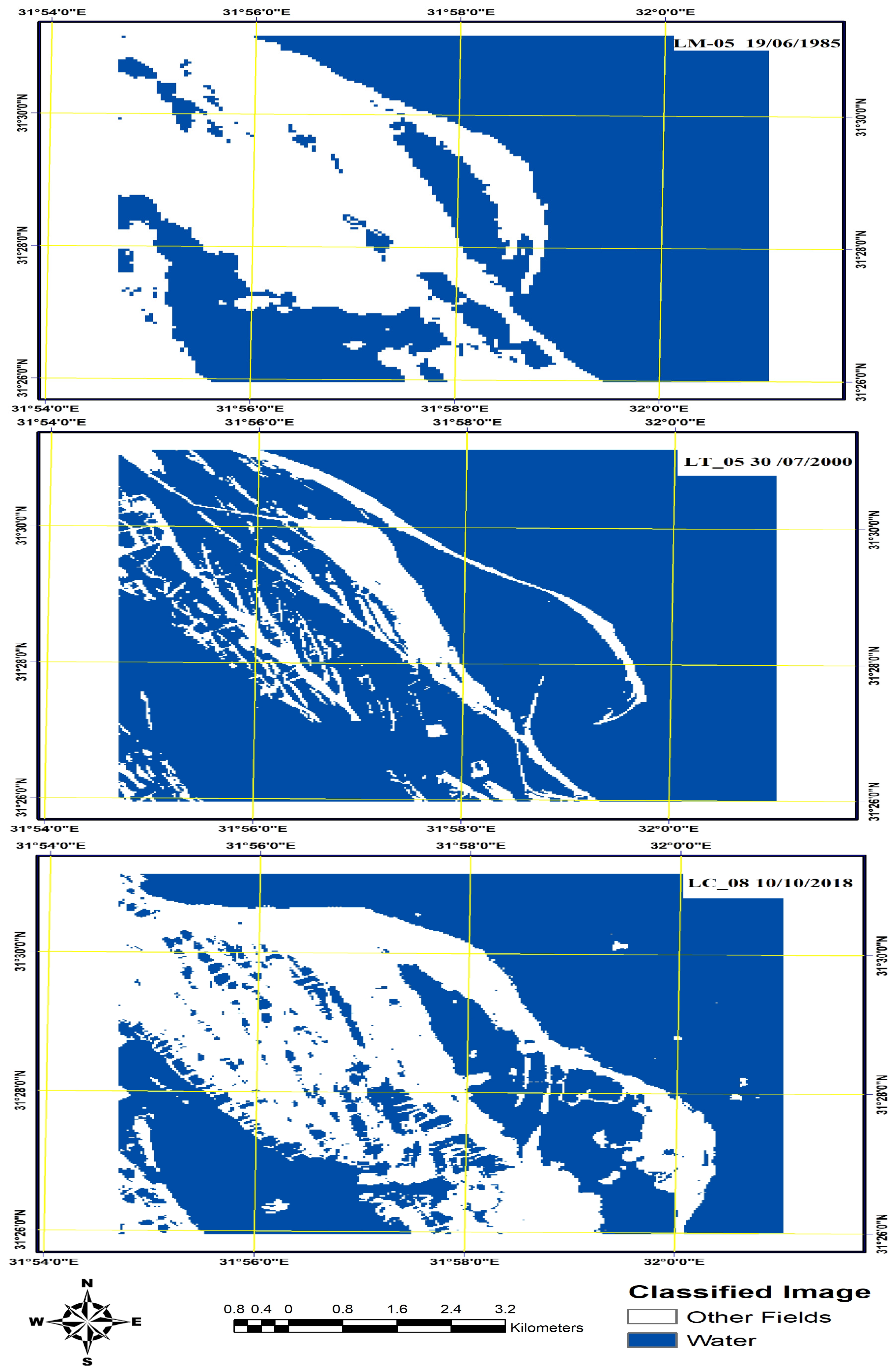
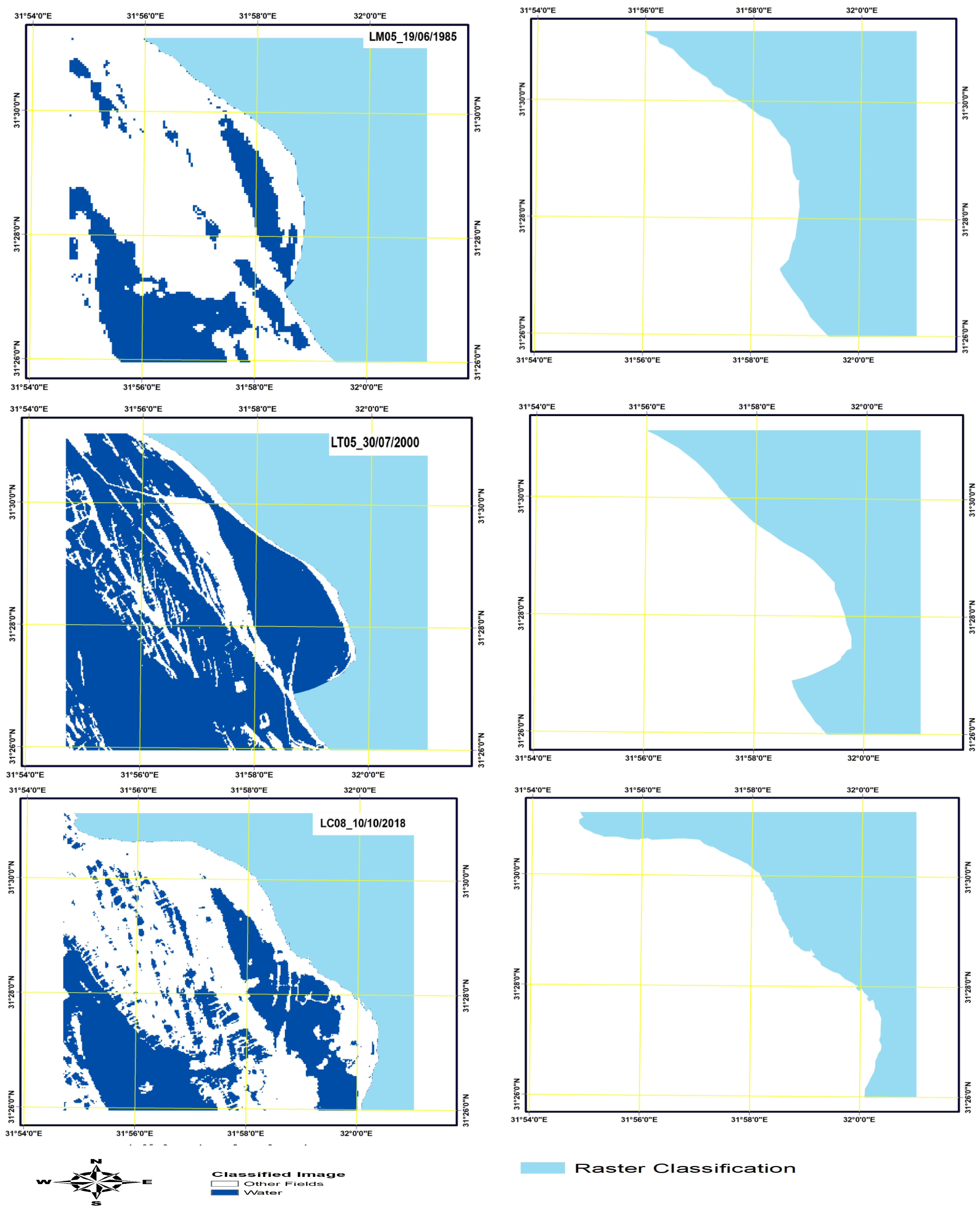
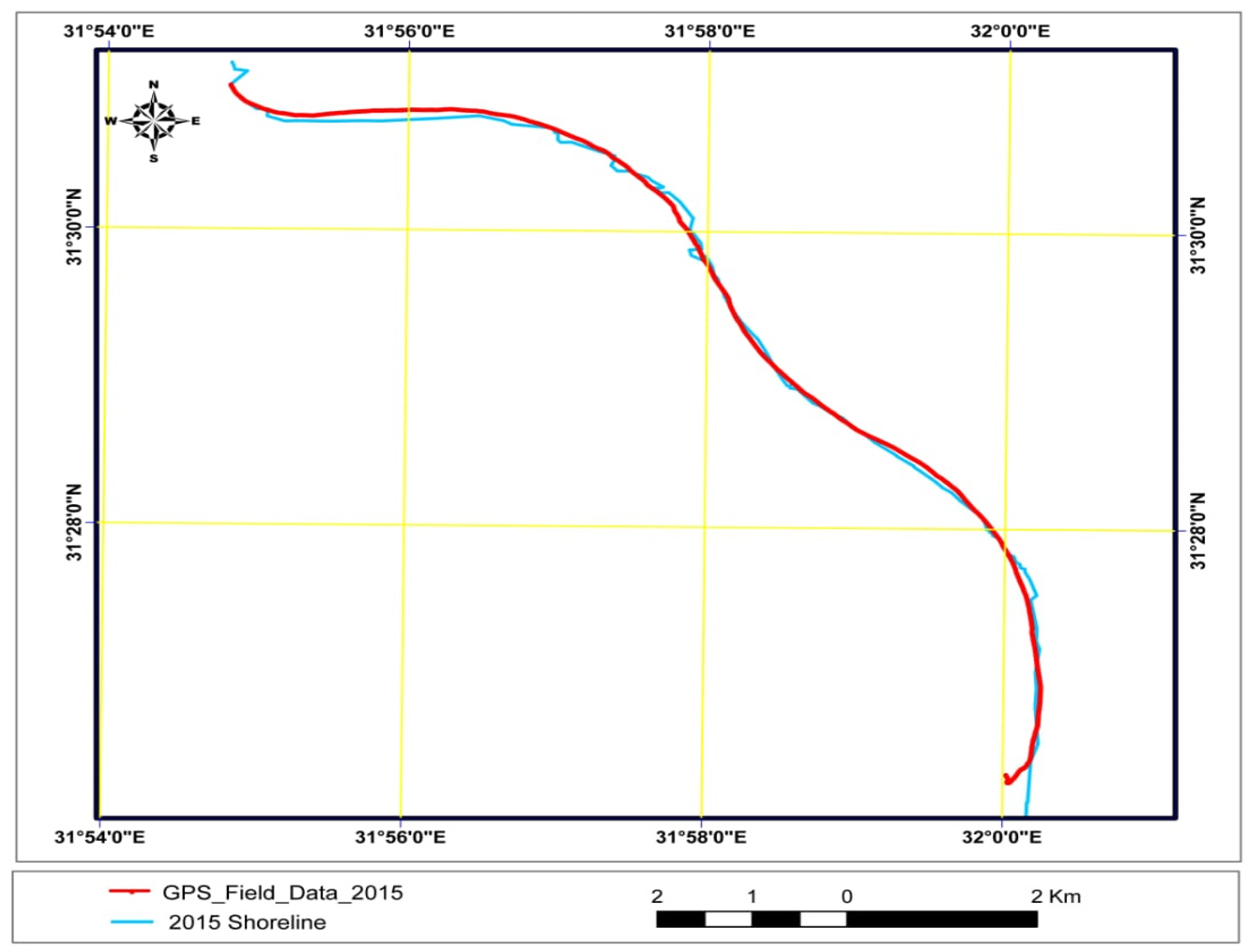

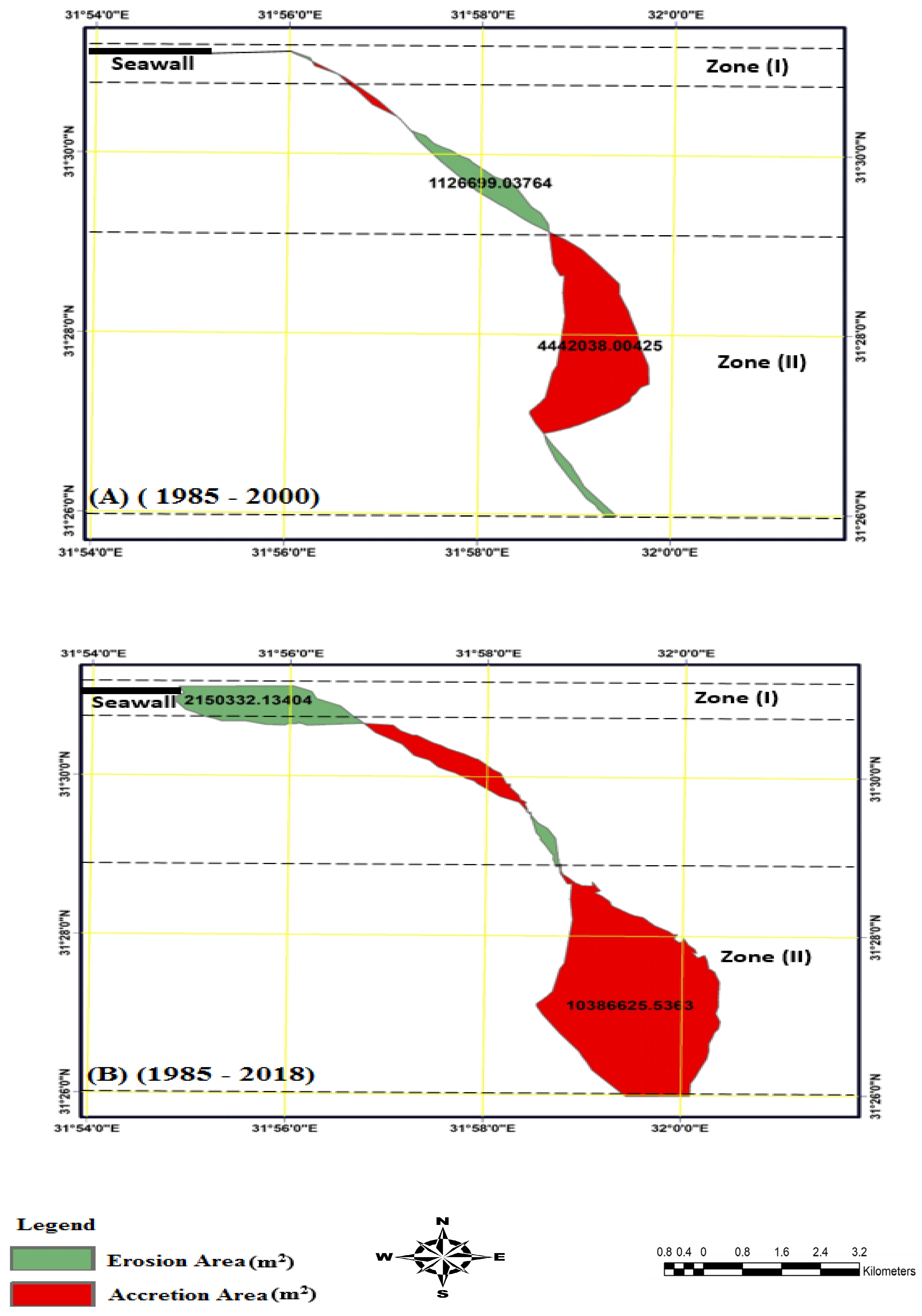
| Satellite and Sensors | Path/Row | Date of Acquisition | Spatial Resolution | Acquired Time (hh:mm:ss) | Tidal Level (cm) |
|---|---|---|---|---|---|
| Landsat 5 (TM) | 177/38 | 19-06-1985 | 30 m | 07:51:28 | ……. |
| Landsat 5 (TM) | 177/38 | 16-05-1990 | 30 m | 07:37:12 | ……. |
| Landsat 5 (TM) | 177/38 | 09-02-1995 | 30 m | 07:53:14 | ……. |
| Landsat 5 (TM) | 177/38 | 30-07-2000 | 30 m | 08:00:38 | 30.7 |
| Landsat 7 (ETM) | 177/38 | 28-07-2005 | 30 m | 08:07:22 | 38 |
| Landsat 7 (ETM) | 177/38 | 14-10-2010 | 30 m | 08:13:25 | 42 |
| Landsat 8 (Oli/TiR) | 177/38 | 24-07-2015 | 15 m | 08:07:18 | 36 |
| Landsat 8 (Oli/TiR) | 177/38 | 10-10-2018 | 15 m | 08:10:04 | 32 |
| Category No | KAPPA Statistics | Strength of Agreement |
|---|---|---|
| 1 | <0.00 | Poor |
| 2 | 0.00–0.20 | Slight |
| 3 | 0.21–0.40 | Fair |
| 4 | 0.41–0.60 | Moderate |
| 5 | 0.61–0.80 | Substantial |
| 6 | 0.81–1.00 | Almost perfect |
| Date of Satellite Image | OA | KAPPA Statistics |
|---|---|---|
| 19-06-1985 | 86.0% | 0.74 |
| 16-05-1990 | 89.0% | 0.76 |
| 09-02-1995 | 90.0% | 0.77 |
| 30-07-2000 | 92.0% | 0.79 |
| 28-07-2005 | 94.0% | 0.79 |
| 14-10-2010 | 95.0% | 0.84 |
| 24-07-2015 | 97.0% | 0.86 |
| 10-10-2018 | 98.0% | 0.86 |
| Date | Area (m2) | Rate of Change (m2/year) | ||
|---|---|---|---|---|
| Erosion | Accretion | Erosion | Accretion | |
| (1985–2000) | 1,126,699 | 4,442,038 | 75,113 | 296,135 |
| (1985–2018) | 2,150,332 | 10,386,625 | 65,161 | 314,746 |
| Research | Time Period | Average Annual Retreat (m/year) | The Used Technique |
|---|---|---|---|
| Esmail et al. [48] | 1990–1999 | 54 |
|
| 1999–2003 | 61.5 | ||
| 2003–2015 | 54.5 | ||
| El-Asmar et al. [50] | 2003–2011 | 61.45 |
|
| Present Study | 2000–2018 | 59 |
|
© 2020 by the authors. Licensee MDPI, Basel, Switzerland. This article is an open access article distributed under the terms and conditions of the Creative Commons Attribution (CC BY) license (http://creativecommons.org/licenses/by/4.0/).
Share and Cite
Elnabwy, M.T.; Elbeltagi, E.; El Banna, M.M.; Elshikh, M.M.Y.; Motawa, I.; Kaloop, M.R. An Approach Based on Landsat Images for Shoreline Monitoring to Support Integrated Coastal Management—A Case Study, Ezbet Elborg, Nile Delta, Egypt. ISPRS Int. J. Geo-Inf. 2020, 9, 199. https://doi.org/10.3390/ijgi9040199
Elnabwy MT, Elbeltagi E, El Banna MM, Elshikh MMY, Motawa I, Kaloop MR. An Approach Based on Landsat Images for Shoreline Monitoring to Support Integrated Coastal Management—A Case Study, Ezbet Elborg, Nile Delta, Egypt. ISPRS International Journal of Geo-Information. 2020; 9(4):199. https://doi.org/10.3390/ijgi9040199
Chicago/Turabian StyleElnabwy, Mohamed T., Emad Elbeltagi, Mahmoud M. El Banna, Mohamed M.Y. Elshikh, Ibrahim Motawa, and Mosbeh R. Kaloop. 2020. "An Approach Based on Landsat Images for Shoreline Monitoring to Support Integrated Coastal Management—A Case Study, Ezbet Elborg, Nile Delta, Egypt" ISPRS International Journal of Geo-Information 9, no. 4: 199. https://doi.org/10.3390/ijgi9040199





